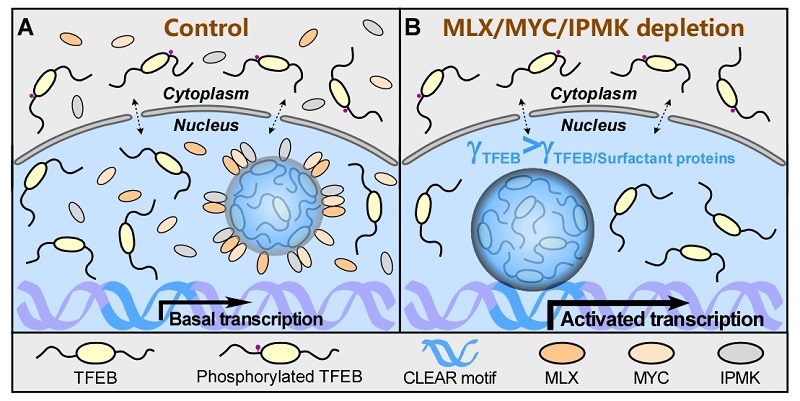Cellular proteins act as surfactants to control the interfacial behavior and function of biological condensates
Biological condensates assembled by liquid-liquid phase separation (LLPS) and phase transition possess unique material properties, including interfacial tension, elasticity, viscosity and so forth, that are closely related to their physiological functions. Interfacial tension of biological condensates plays essential roles in various intracellular processes, such as the architecture of coexisting liquid phases for nucleolus assembly and autophagosome formation. Surfactants adsorbed by interfaces between two immiscible phases reduce the interfacial tension, and modulate various interfacial behaviors. However, very little is known about whether the interfacial tension of biological condensates and their consequent functions can be modulated by endogenous cellular surfactants under physiological conditions.
A research group led by Prof. ZHANG Hong from the Institute of Biophysics of Chinese Academy of Sciences revealed that cellular proteins may act as surfactants to modulate the interfacial tension and function of biological condensates. This study is published online in Developmental Cell.
TFEB, the master transcription factor controlling expression of autophagic-lysosomal genes, undergoes LLPS to assemble transcriptional condensates for the expression of target genes. The researchers found that the transcription regulator, MLX, extensively colocalizes with the nuclear TFEB condensates, and suppresses the access of TFEB to the promoter regions of autophagic-lysosomal genes, so as to negatively regulate the autophagy-lysosome pathway (ALP).
Using in vitro recombinant LLPS systems, researchers found that DNA probe that specifically binds TFEB, is adsorbed onto the surface of TFEB droplets; addition of MLX suppresses this surface adsorption. MLX coats the surface of TFEB droplets, and dramatically lowers the interfacial tension of TFEB droplets, suggesting that MLX is a specific surfactant for TFEB droplets. Specific DNA probe also acts as the surfactant of TFEB droplets. These results indicated that interfacial tension drives TFEB condensates to bind to target DNA for the transcriptional initiation of downstream genes; the surfactant protein MLX lowers the interfacial tension and consequent DNA affinity and transcriptional activity of TFEB condensates.
Next, the researchers found that the transcription regulators, IPMK and MYC, also act as surfactants to reduce the interfacial tension and consequent DNA affinity and transcriptional activity of TFEB condensates. Moreover, MLX, IPMK and MYC show synergistic effect in controlling the interfacial tension and functions of TFEB droplets. MLX, IPMK and MYC act as synergistic surfactants of TFEB condensates to coordinately modulate the activity of ALP.
Finally, the researchers found that the activities of transcriptional condensates formed by other transcription factors can also be modulated by their interfacial tension. The transcription regulators, RUNX3 and HOXA4, act as synergistic surfactants to modulate the interfacial tension and consequent DNA affinity of transcription factor condensates formed by TAZ-TEAD4.
Altogether, this study reveals a quantitatively correlation between the interfacial tension of TFEB condensates and the activity of ALP, and indicates that cellular proteins may act as surfactant to modulate the interfacial tension, behaviors and functions of biological condensates under physiological conditions.

Fig. MLX, IPMK and MYC act as synergistic surfactants to modulate the interfacial tension and transcriptional activity of TFEB condensates
Article link:https://doi.org/10.1016/j.devcel.2023.04.004
Contact: ZHANG Hong
Institute of Biophysics, Chinese Academy of Sciences
Beijing 100101, China
Email: hongzhang@ibp.ac.cn
(Reported by Dr. ZHANG Hong's group)

